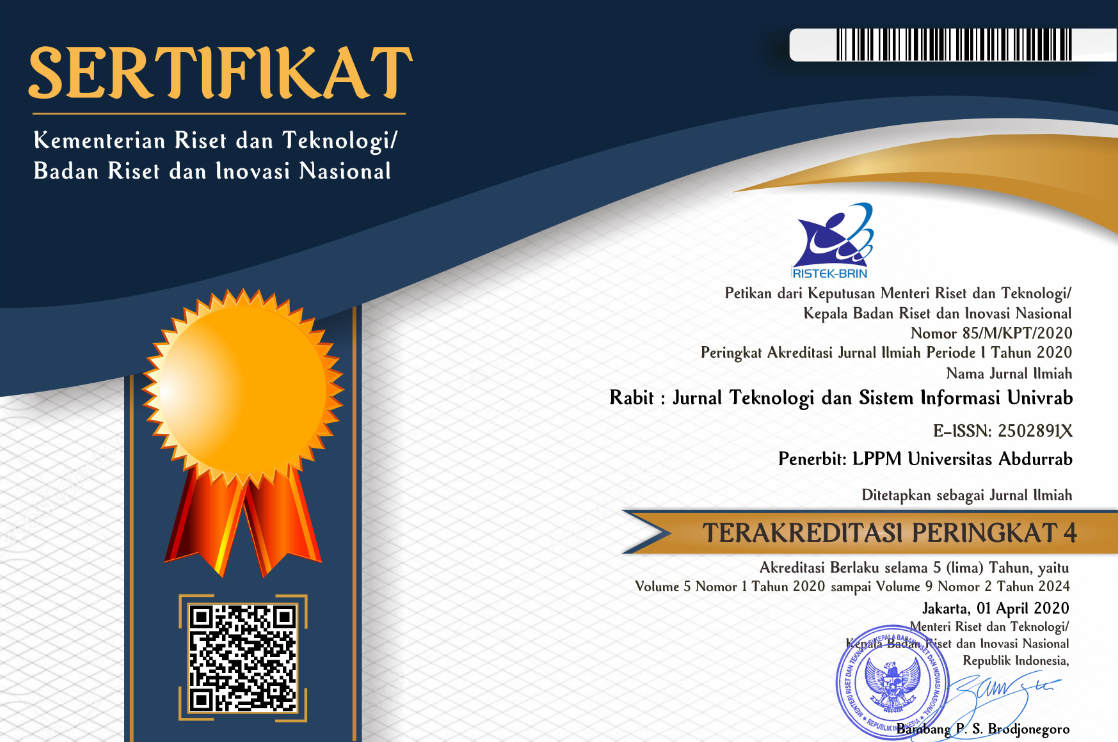ANALISIS SENTIMEN PENGGUNA APLIKASI CHATGPT BERDASARKAN RATING MENGGUNAKAN METODE LEXICON
Abstract
The study aims to evaluate the feelings of ChatGPT users based on the given rating, using lexicon methods to classify feelings in user comments without requiring prior class labels. This lexicon method uses the vader lexicon dictionary to calculate the sentimental polarity of words in comments. The comment data set is obtained from an external source, namely the Kaggle data set, which did not have a previous sentiment label. The lexicon model is applied as an unsupervised learning approach to understanding the expression of user sentiment. The comments in the dataset are processed and analyzed using a lexicon model. The results of this sentimental analysis show that the lexicon method produces comments that tend to be positive or negative for the rating range one to five. Nonetheless, research findings suggest that some aspects of sentiment may not be accurately detected by this method. Nevertheless, this sentiment analysis provides an important basis for further understanding of the interaction between users and applications. These results can be the basis for more in-depth research involving more sophisticated approaches to sentiment analysis.
References
B. Liu, Sentiment analysis: Mining opinions, sentiments, and emotions. 2015. doi: 10.1017/CBO9781139084789.
K. Arun and A. Srinagesh, “Multi-lingual Twitter sentiment analysis using machine learning,” International Journal of Electrical and Computer Engineering, vol. 10, no. 6, pp. 5992–6000, 2020, doi: 10.11591/ijece.v10i6.pp5992-6000.
A. Baliyan, A. Batra, and S. P. Singh, “Multilingual sentiment analysis using RNN-LSTM and neural machine translation,” in Proceedings of the 2021 8th International Conference on Computing for Sustainable Global Development, INDIACom 2021, 2021. doi: 10.1109/INDIACom51348.2021.00126.
A. Mehta, Y. Parekh, and S. Karamchandani, “Performance evaluation of machine learning and deep learning techniques for sentiment analysis,” in Advances in Intelligent Systems and Computing, 2018. doi: 10.1007/978-981-10-7512-4_46.
P. Cen, K. Zhang, and D. Zheng, “Sentiment Analysis Using Deep Learning Approach,” vol. 2, no. 1, pp. 17–27, 2020, doi: 10.32604/jai.2020.010132.
M. Heikal, “ScienceDirect Sentiment Analysis of Arabic Tweets using Deep Learning Sentiment Analysis of ∗ Arabic Tweets using Deep Learning,” Procedia Comput Sci, vol. 142, pp. 114–122, 2018, doi: 10.1016/j.procs.2018.10.466.
C. N. Dang, M. N. Moreno-García, and F. De La Prieta, “Hybrid Deep Learning Models for Sentiment Analysis,” Complexity, vol. 2021, 2021, doi: 10.1155/2021/9986920.
C. N. Dang, M. N. Moreno-García, and F. De La Prieta, “Hybrid Deep Learning Models for Sentiment Analysis,” Complexity, vol. 2021, 2021, doi: 10.1155/2021/9986920.
P. Sreevidya, S. Veni, A. V. Vidyapeetham, A. V. Vidyapeetham, and A. Info, “Sentiment analysis by deep learning approaches 1,3,” vol. 18, no. 2, pp. 752–760, 2020, doi: 10.12928/TELKOMNIKA.v18i2.13912.
M. Muadin and H. Asnal, “Implementasi Metode Support Vector Machine Pada Opinion Mining Masyarakat Terkait Chatgpt,” JOISIE Journal Of Information System And Informatics Engineering, vol. 7, no. 1, pp. 78–84, 2023.
A. Erfina and M. Rifki Nurul, “Implementation of Naive Bayes classification algorithm for Twitter user sentiment analysis on ChatGPT using Python programming language,” Data & Metadata, vol. 2, p. 45, Jun. 2023, doi: 10.56294/dm202345.
Y. Albalawi, J. Buckley, and N. S. Nikolov, “Investigating the impact of pre-processing techniques and pre-trained word embeddings in detecting Arabic health information on social media,” J Big Data, vol. 8, no. 1, 2021, doi: 10.1186/s40537-021-00488-w.
A. F. Hidayatullah and M. R. Ma’arif, “Pre-processing Tasks in Indonesian Twitter Messages,” J Phys Conf Ser, vol. 755, no. 1, 2016, doi: 10.1088/1742-6596/755/1/011001.
S. Mujilahwati, “Pre-Processing Text Mining Pada Data Twitter,” Seminar Nasional Teknologi Informasi dan Komunikasi, vol. 2016, no. Sentika, pp. 2089–9815, 2016.
R. Feldman and J. Sanger, “Text Mining Preprocessing Techniques,” in The Text Mining Handbook, Cambridge University Press, 2006, pp. 57–63. doi: 10.1017/CBO9780511546914.004.
Copyright (c) 2024 Rabit : Jurnal Teknologi dan Sistem Informasi Univrab

This work is licensed under a Creative Commons Attribution-NonCommercial-ShareAlike 4.0 International License.
Copyright Notice
The copyright of the received article shall be assigned to the publisher of the journal. The intended copyright includes the right to publish the article in various forms (including reprints). The journal maintains the publishing rights to published articles. Therefore, the author must submit a statement of the Copyright Transfer Agreement.*)
This work is licensed under a Creative Commons Attribution-NonCommercial-ShareAlike 4.0 International License.
In line with the license, authors and any users (readers and other researchers) are allowed to share and adapt the material only for non-commercial purposes. In addition, the material must be given appropriate credit, provided with a link to the license, and indicated if changes were made. If authors remix, transform or build upon the material, authors must distribute their contributions under the same license as the original.
Please find the rights and licenses in RABIT : Jurnal Teknologi dan Sistem Informasi Univrab. By submitting the article/manuscript of the article, the author(s) accept this policy.
1. License
The non-commercial use of the article will be governed by the Creative Commons Attribution license as currently displayed on Creative Commons Attribution-NonCommercial-ShareAlike 4.0 International License.
2. Author’s Warranties
The author warrants that the article is original, written by stated author(s), has not been published before, contains no unlawful statements, does not infringe the rights of others, is subject to copyright that is vested exclusively in the author and free of any third party rights, and that any necessary written permissions to quote from other sources have been obtained by the author(s).
3. User Rights
RABIT's spirit is to disseminate articles published are as free as possible. Under the Creative Commons license, RABIT permits users to copy, distribute, display, and perform the work for non-commercial purposes only. Users will also need to attribute authors and RABIT on distributing works in the journal.
4. Rights of Authors
Authors retain all their rights to the published works, such as (but not limited to) the following rights;
- Copyright and other proprietary rights relating to the article, such as patent rights,
- The right to use the substance of the article in own future works, including lectures and books,
- The right to reproduce the article for own purposes,
- The right to self-archive the article,
- The right to enter into separate, additional contractual arrangements for the non-exclusive distribution of the article's published version (e.g., post it to an institutional repository or publish it in a book), with an acknowledgment of its initial publication in this journal (RABIT : Jurnal Teknologi dan Sistem Informasi Univrab).
5. Co-Authorship
If the article was jointly prepared by other authors, any authors submitting the manuscript warrants that he/she has been authorized by all co-authors to be agreed on this copyright and license notice (agreement) on their behalf, and agrees to inform his/her co-authors of the terms of this policy. RABIT will not be held liable for anything that may arise due to the author(s) internal dispute. RABIT will only communicate with the corresponding author.
6. Royalties
This agreement entitles the author to no royalties or other fees. To such extent as legally permissible, the author waives his or her right to collect royalties relative to the article in respect of any use of the article by RABIT.
7. Miscellaneous
RABIT will publish the article (or have it published) in the journal if the article’s editorial process is successfully completed. RABIT's editors may modify the article to a style of punctuation, spelling, capitalization, referencing and usage that deems appropriate. The author acknowledges that the article may be published so that it will be publicly accessible and such access will be free of charge for the readers as mentioned in point 3.
 PDF (Bahasa Indonesia)
PDF (Bahasa Indonesia)
 Abstract views: 125
Abstract views: 125
 downloads: 118
downloads: 118

 :
:












